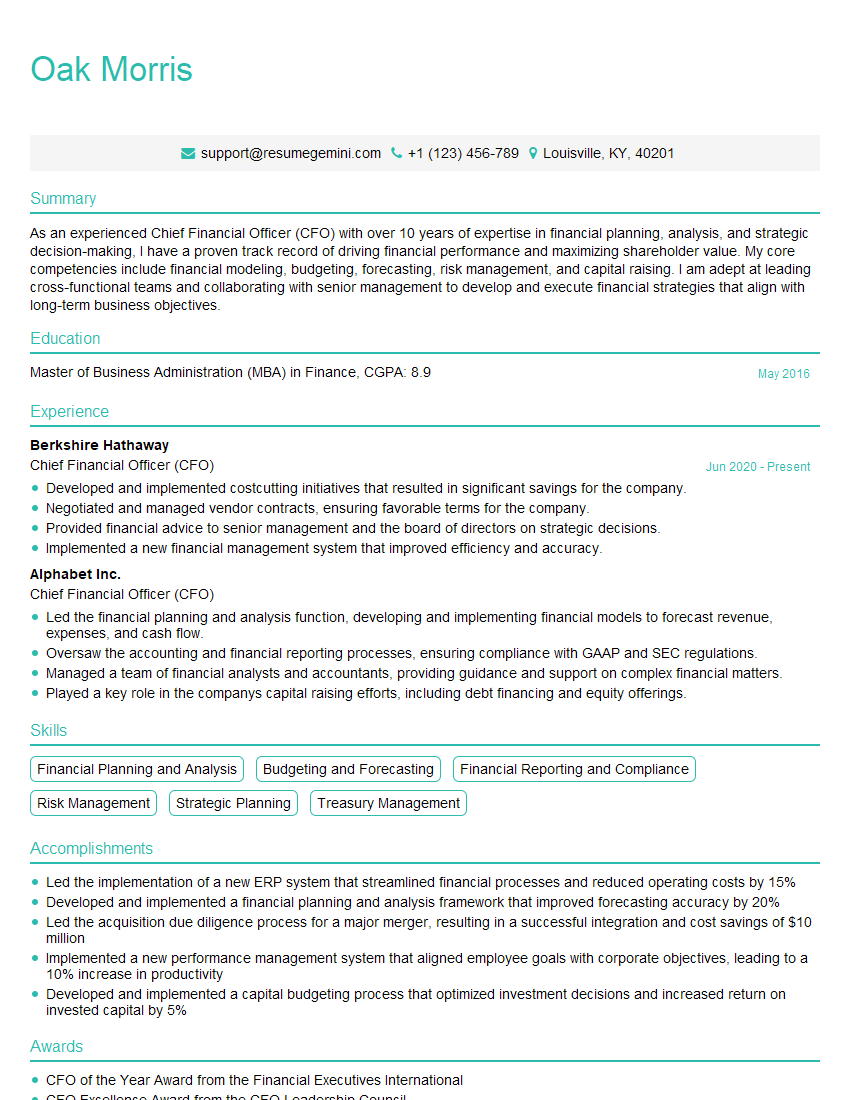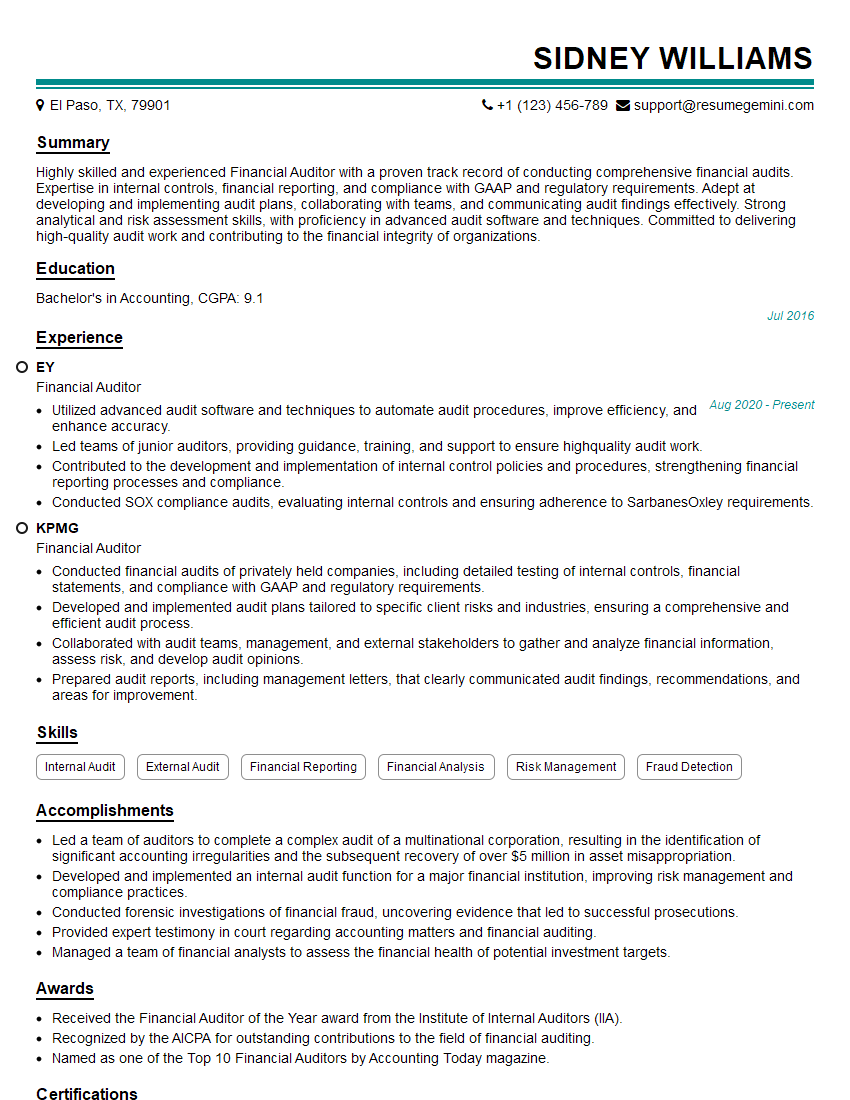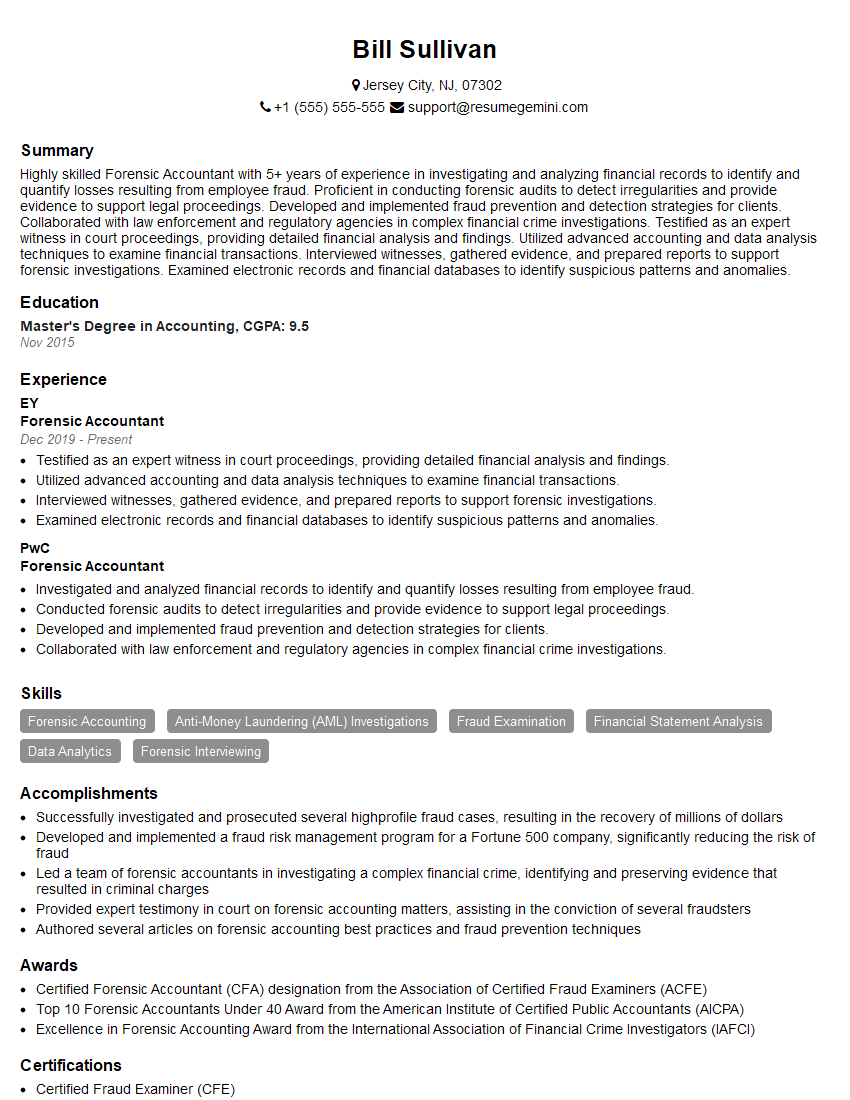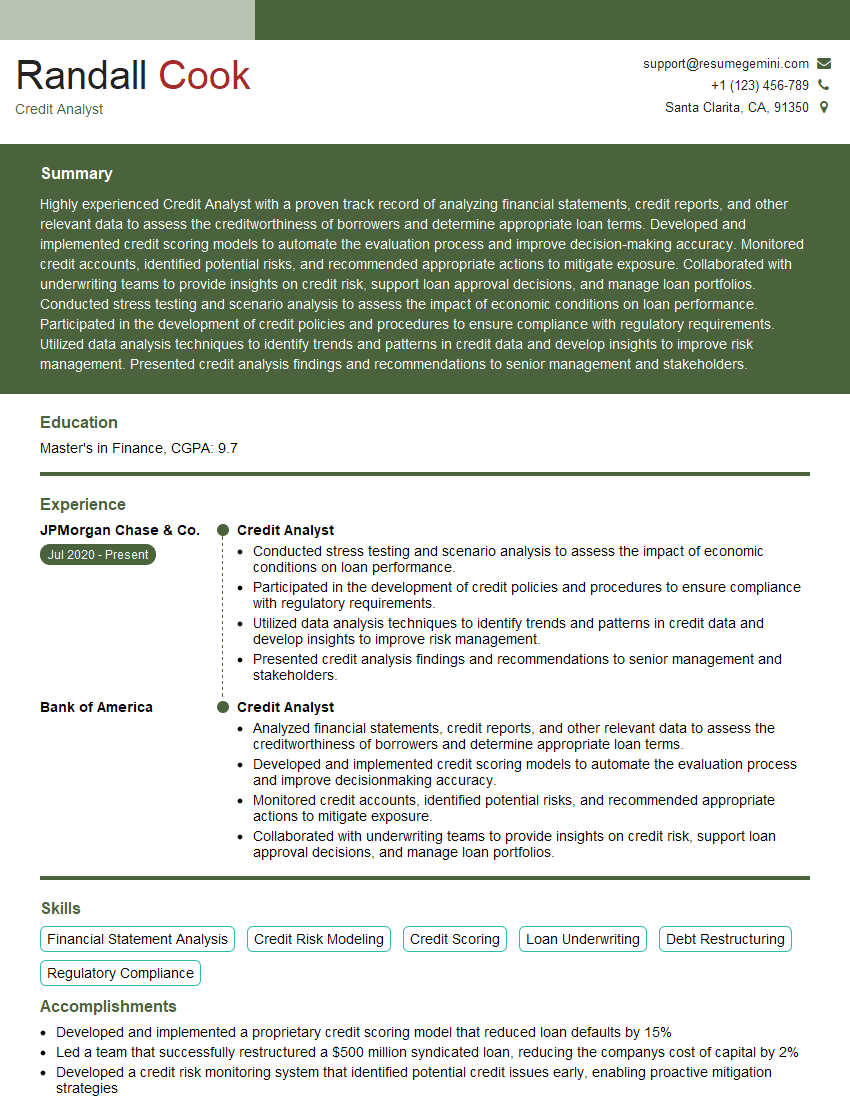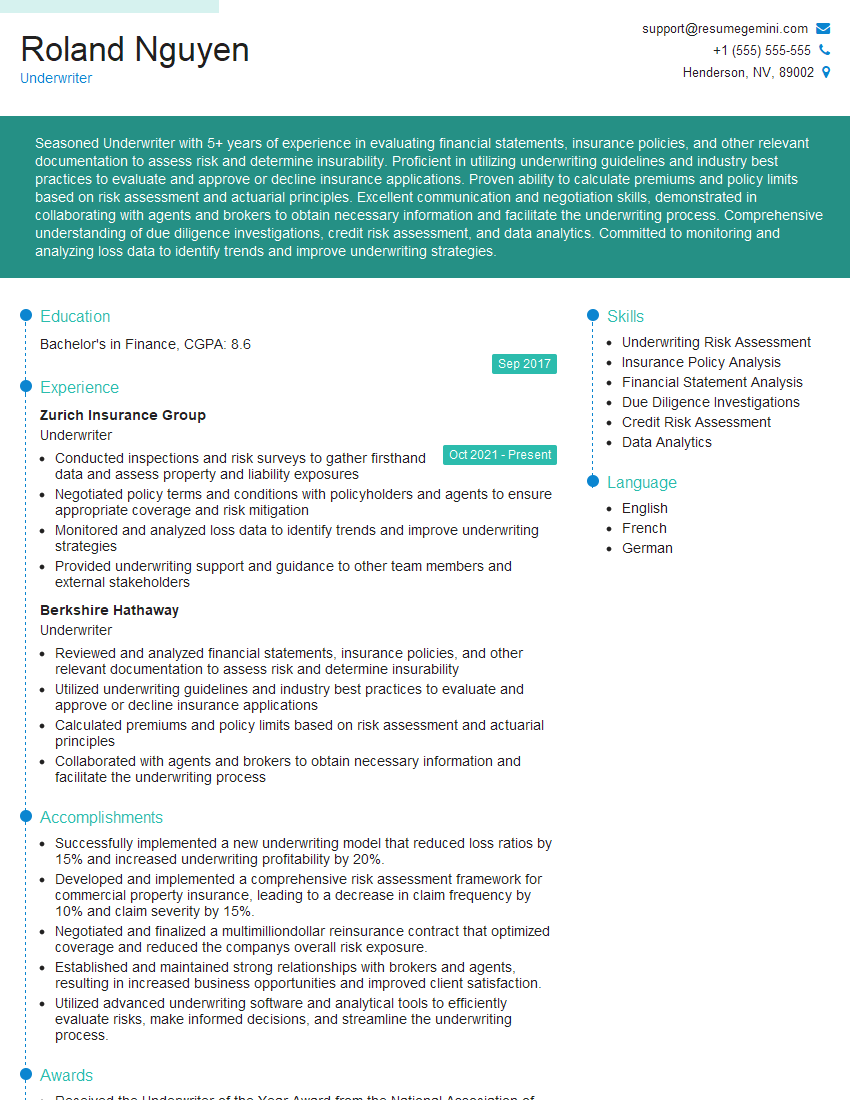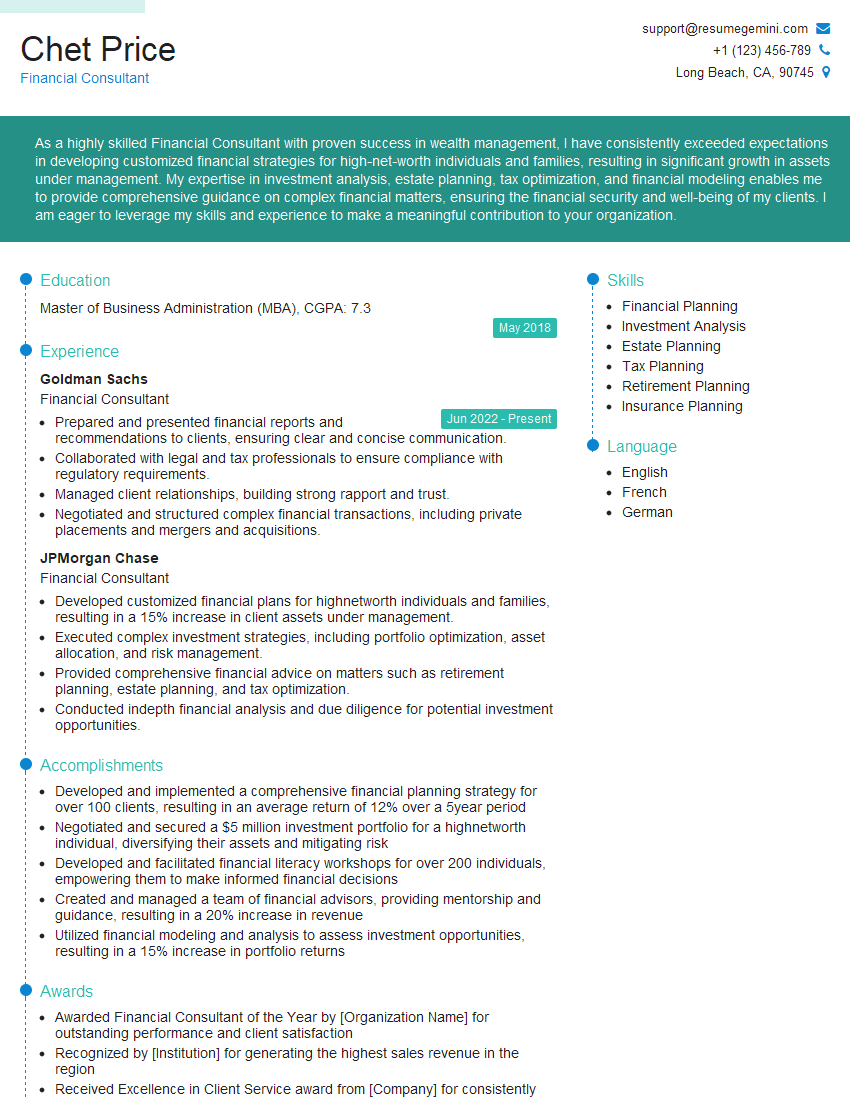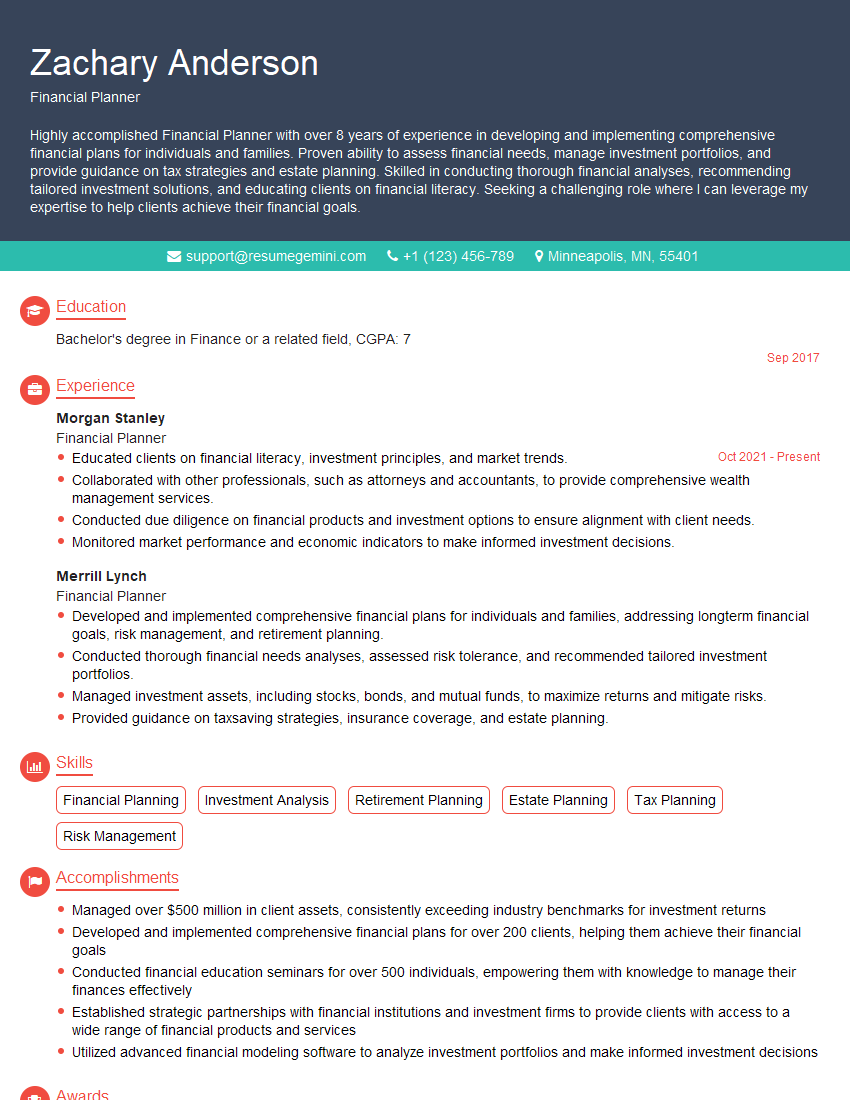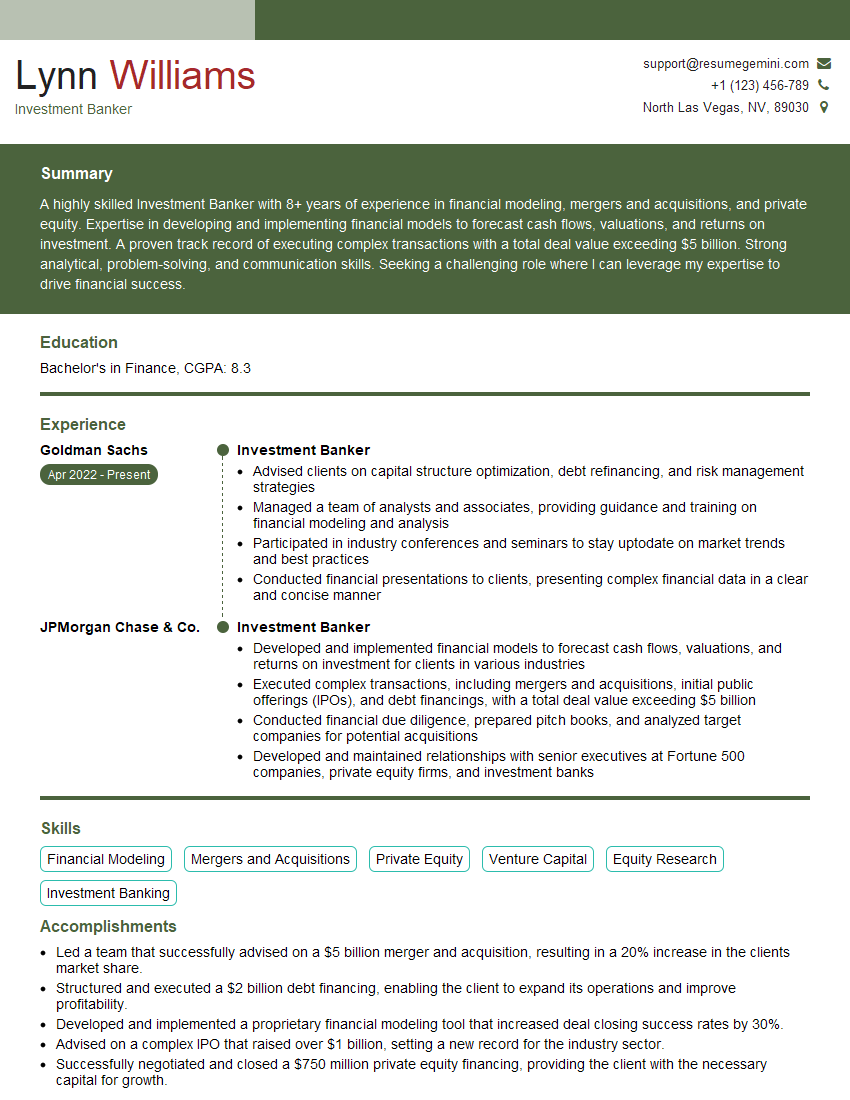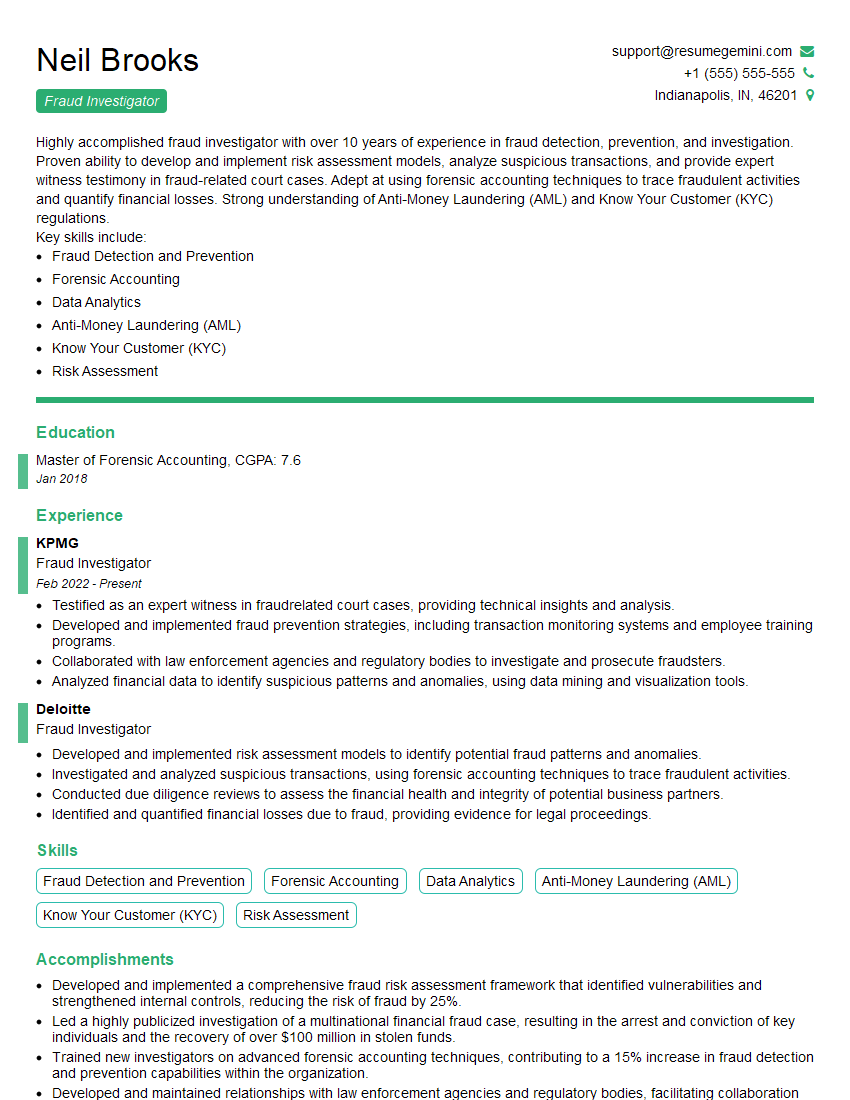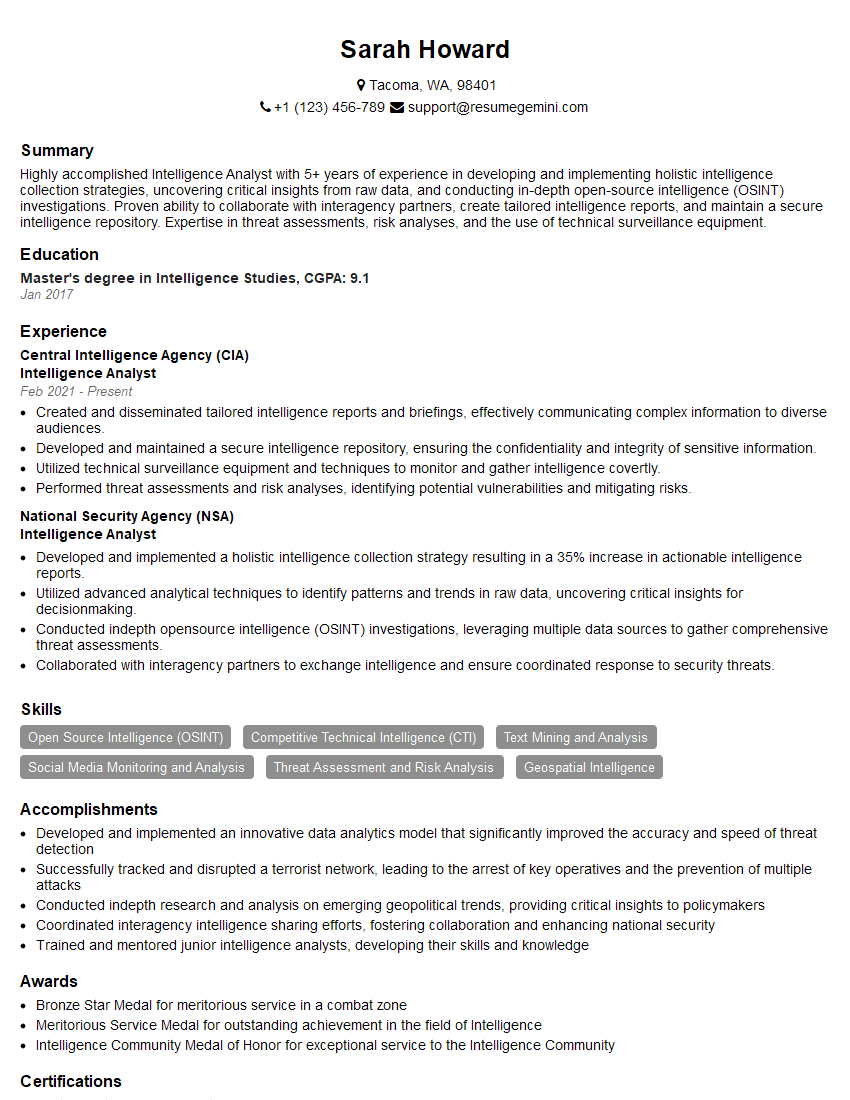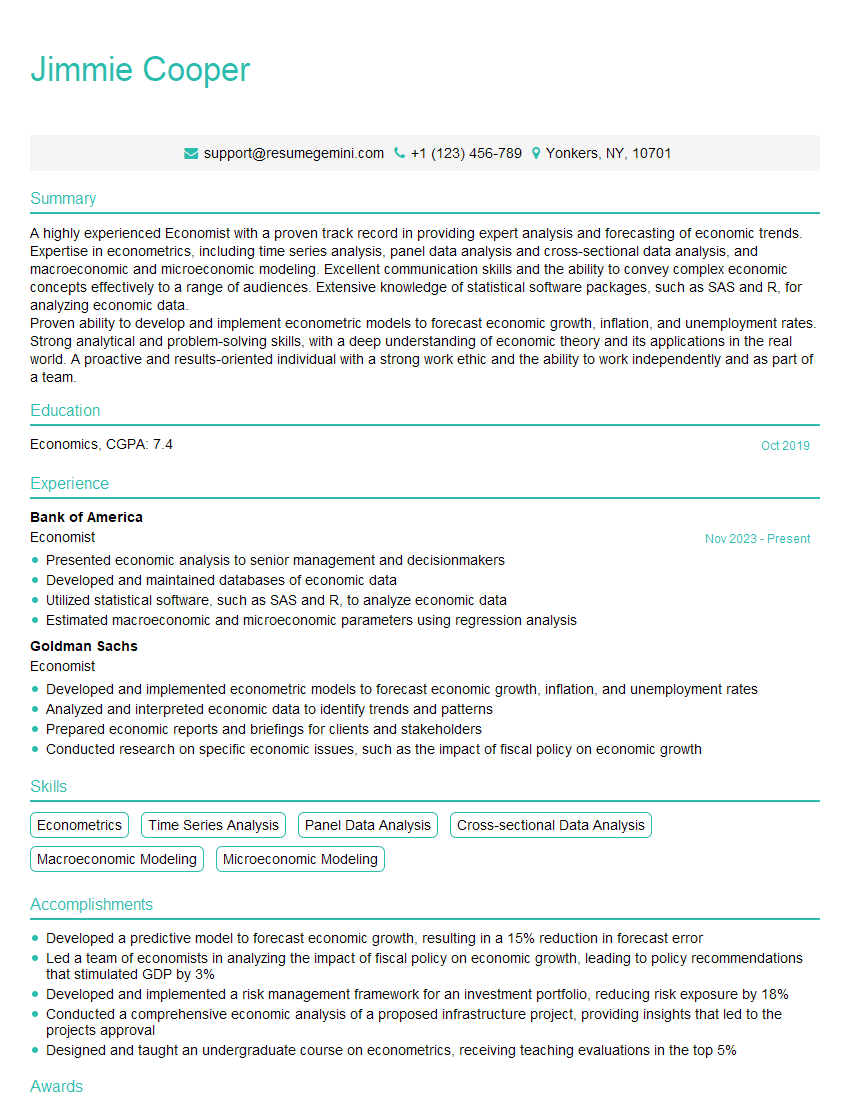Every successful interview starts with knowing what to expect. In this blog, we’ll take you through the top Financial Intelligence interview questions, breaking them down with expert tips to help you deliver impactful answers. Step into your next interview fully prepared and ready to succeed.
Questions Asked in Financial Intelligence Interview
Q 1. Explain the concept of ‘Know Your Customer’ (KYC) and its importance in financial crime prevention.
Know Your Customer (KYC) is a crucial process in financial services designed to verify the identity of clients and understand their business activities. It’s the cornerstone of preventing financial crime, acting as the first line of defense against money laundering, terrorist financing, and other illicit activities. Think of it as a thorough background check for your customers, ensuring you know who you’re dealing with.
Its importance stems from the fact that criminals often use shell companies, aliases, and complex financial structures to obscure their identities and the origins of their funds. KYC helps identify these red flags early. A robust KYC program involves collecting, verifying, and updating customer information, including identification documents, proof of address, and details of the nature and source of their funds. This helps financial institutions meet regulatory compliance requirements and reduces their risk exposure.
For example, a bank refusing to onboard a client without proper identification demonstrates effective KYC practices. Conversely, a bank that overlooks incomplete or suspicious documentation can face severe penalties and reputational damage.
Q 2. Describe the process of identifying suspicious activity in financial transactions.
Identifying suspicious activity requires a multi-faceted approach combining technological tools with human expertise. It involves analyzing transactional data for patterns and anomalies that deviate from typical customer behavior. This might include unusually large transactions, frequent transactions with high-risk jurisdictions, or complex transactions involving multiple entities.
The process begins with establishing a baseline of normal activity for each customer. Then, sophisticated algorithms and monitoring systems flag transactions that fall outside these parameters. For instance, a sudden increase in deposit volume from an individual known to have low income would raise a red flag. Human analysts then review these flagged transactions, considering contextual information such as the customer’s occupation, known associates, and overall transaction history to determine whether they are genuinely suspicious. This often involves consulting internal databases, external watchlists, and collaborating with law enforcement where necessary.
Consider a scenario where a customer regularly deposits small amounts of cash but suddenly makes a large wire transfer to an offshore account. This pattern, while not inherently illegal, warrants closer scrutiny and could indicate money laundering activity.
Q 3. What are the key components of an effective Anti-Money Laundering (AML) compliance program?
An effective Anti-Money Laundering (AML) compliance program is not a single measure, but a comprehensive system. Its key components include:
- Customer Due Diligence (CDD): Implementing robust KYC procedures to verify customer identity and understand their business activities.
- Transaction Monitoring: Establishing systems to identify suspicious transactions, using both rule-based and AI-driven technologies.
- Sanctions Screening: Regularly screening customers and transactions against sanctions lists maintained by relevant authorities (e.g., OFAC, UN).
- Risk Assessment: Regularly assessing the organization’s overall AML risk profile, identifying vulnerabilities, and implementing mitigation strategies.
- Employee Training: Providing regular training to employees on AML regulations, procedures, and the identification of suspicious activity.
- Record Keeping: Maintaining accurate and readily accessible records of all KYC, transaction monitoring, and sanctions screening activities.
- Independent Audits: Conducting regular independent audits to assess the effectiveness of the AML program.
- Suspicious Activity Reporting (SAR): Filing timely and accurate SARs with the appropriate Financial Intelligence Unit (FIU) when suspicious activity is detected.
Each component is crucial; weakness in one area can compromise the entire program’s effectiveness. A strong AML program is a dynamic process requiring continuous adaptation to evolving threats and regulatory changes.
Q 4. How would you assess the risk of money laundering in a specific industry or transaction?
Assessing money laundering risk involves a systematic approach that considers various factors specific to the industry and transaction. It’s essentially a risk-based approach.
Steps to assess risk:
- Identify the industry: High-risk industries like casinos, real estate, and precious metals trading are inherently more susceptible to money laundering.
- Analyze the transaction: Consider the transaction’s size, complexity, and the parties involved. Unusually large transactions, complex layering schemes, or involvement of shell companies are red flags.
- Evaluate the customer’s profile: Assess the customer’s business, reputation, and geographic location. Customers from high-risk jurisdictions or with opaque business operations pose higher risk.
- Consider geographic factors: Transactions involving high-risk countries or jurisdictions with weak AML regulations are more prone to money laundering.
- Review existing data: Analyze historical data on customer behavior, transactions, and any previous red flags.
- Assign a risk rating: Based on the assessment, assign a risk rating (low, medium, high) to the industry and the specific transaction.
Example: A real estate transaction involving an anonymous buyer purchasing a high-value property with cash from a high-risk jurisdiction would warrant a higher risk assessment compared to a standard mortgage-funded purchase.
Q 5. Explain the role of a Financial Intelligence Unit (FIU) and its interaction with other law enforcement agencies.
A Financial Intelligence Unit (FIU) is a central, national agency responsible for receiving, analyzing, and disseminating financial intelligence to combat money laundering and other financial crimes. They act as a crucial link between financial institutions and law enforcement.
Role of an FIU:
- Receiving SARs: FIUs receive Suspicious Activity Reports (SARs) from financial institutions.
- Analyzing intelligence: They analyze the received information to identify patterns, networks, and potential criminal activities.
- Disseminating intelligence: They share the analyzed intelligence with relevant law enforcement agencies, both domestically and internationally, to facilitate investigations and prosecutions.
- International cooperation: FIUs collaborate with their counterparts in other countries to track cross-border financial flows and dismantle transnational criminal networks.
Interaction with law enforcement: FIUs work closely with various law enforcement agencies such as police departments, prosecutors’ offices, and tax authorities. They provide crucial intelligence to support investigations, helping law enforcement build cases and bring perpetrators to justice.
For example, an FIU might identify a network of shell companies involved in an international drug trafficking operation by analyzing SARs from multiple financial institutions. They would then share this intelligence with relevant law enforcement agencies to facilitate the investigation and potential arrests.
Q 6. What are some common red flags indicating potential financial crime?
Common red flags indicating potential financial crime are numerous and vary depending on context. However, some common indicators include:
- Structuring transactions: Breaking down a large transaction into smaller ones to avoid detection.
- Unusual wire transfers: Large or frequent wire transfers to high-risk jurisdictions.
- Cash transactions exceeding reporting thresholds: Depositing or withdrawing unusually large amounts of cash.
- Use of shell companies or nominees: Using entities with opaque ownership structures to obscure the true beneficiaries.
- Sudden increase in deposits or activity: A dramatic shift in the volume or nature of transactions.
- Lack of plausible explanation for funds: Inability to justify the source or purpose of funds.
- Suspicious relationships with known criminals: Associations with individuals or entities linked to criminal activities.
It’s crucial to understand that a single red flag doesn’t necessarily confirm criminal activity. However, the presence of multiple red flags, especially in combination, warrants further investigation and reporting.
Q 7. Describe your experience with sanctions screening and compliance.
Throughout my career, I have extensive experience in sanctions screening and compliance, working with various global sanctions programs (e.g., OFAC, EU, UN). My responsibilities have included implementing and maintaining sanctions screening programs, training staff, managing investigations, and responding to regulatory inquiries.
I’ve utilized various screening technologies, including both standalone platforms and those integrated into wider AML systems. This has involved developing and implementing robust screening workflows that minimize false positives while ensuring high detection rates. A key aspect of my work has been staying abreast of evolving sanctions regulations and ensuring our processes accurately reflect these updates. I have managed numerous scenarios where sanctions hits were flagged, including cases requiring in-depth investigations to confirm the identity and status of individuals and entities.
I have successfully conducted numerous investigations into potential sanctions violations and facilitated the creation of compliance training material that includes real-world case studies and best-practice solutions. My focus has always been on building compliant and resilient systems that effectively mitigate sanctions risk, helping to maintain the institution’s reputation and protect against financial penalties.
Q 8. How do you determine the beneficial ownership of a company or entity?
Determining beneficial ownership, crucial for combating financial crime, involves identifying the natural person(s) who ultimately own or control a company or entity. It’s not just about looking at the registered owner; it’s about peeling back the layers to find the real person pulling the strings. This often involves tracing ownership through various corporate structures, trusts, and nominee arrangements.
My approach involves a multi-layered investigation, using a combination of publicly available information and specialized databases. I begin with reviewing the company’s registration documents, shareholder registers, and articles of association. Then, I delve into databases like those maintained by financial intelligence units (FIUs), which may provide information on ultimate beneficial owners (UBOs). I also utilize commercial databases that can uncover relationships between companies and individuals, revealing complex ownership structures. For example, I might uncover a shell company registered in a tax haven, leading me to investigate further to identify the real person ultimately controlling the assets.
Consider a scenario where a company is registered in the British Virgin Islands, with a nominee director and several layers of subsidiaries. Simply looking at the registered address wouldn’t reveal the beneficial owner. A thorough investigation would involve analyzing the beneficial ownership information provided by the FIU, reviewing bank statements and transaction records of the subsidiary companies, examining the contracts and agreements of the nominee director, and potentially utilizing open-source intelligence techniques to uncover the identity of the actual controller.
Q 9. What are the differences between regulatory reporting requirements for banks and non-bank financial institutions?
Regulatory reporting requirements differ significantly between banks and non-bank financial institutions (NBFIs) due to their varying roles within the financial system and associated risks. Banks, due to their systemic importance and extensive customer base, face considerably more stringent regulations.
- Banks: Subject to comprehensive regulations concerning anti-money laundering (AML), combating the financing of terrorism (CFT), know your customer (KYC), and customer due diligence (CDD). Reporting requirements are extensive, including suspicious activity reports (SARs), transaction monitoring, and regular audits. They are also subject to more frequent and rigorous on-site examinations.
- NBFIs: These institutions, encompassing a wide range of entities (e.g., money service businesses, investment firms, insurance companies), face reporting requirements tailored to their specific activities. While AML/CFT obligations generally apply, the specifics, frequency, and scope of reporting vary significantly based on risk profiles. For example, a smaller money transfer business will have less stringent requirements than a large hedge fund. The regulatory burden is generally less intensive than for banks.
The key difference lies in the level of scrutiny and the breadth of reporting. Banks, as custodians of larger volumes of funds, are viewed as posing higher risk and thus receive far greater regulatory attention. This is reflected in stricter reporting requirements, more frequent audits, and greater penalties for non-compliance.
Q 10. What are your skills in using financial databases and intelligence tools?
I possess extensive experience in using various financial databases and intelligence tools. My expertise spans a range of platforms, including those used to access transaction data, company registry information, and sanctions lists. I am proficient in using tools such as World-Check, Dow Jones Risk & Compliance, LexisNexis, and various FIU databases.
My skills extend beyond simple data retrieval. I can effectively analyze complex datasets, identify suspicious patterns and anomalies, construct network diagrams to visualize relationships between entities, and use advanced search techniques to refine investigations. For instance, I’m skilled in utilizing Boolean search operators and regular expressions to efficiently filter vast quantities of data, quickly pinpointing relevant information in a sea of irrelevant details. I am also comfortable interpreting and analyzing different data formats, such as structured databases, CSV files, and unstructured text data from news articles and other sources.
Q 11. How would you investigate a suspected case of fraud involving wire transfers?
Investigating suspected fraud involving wire transfers requires a systematic and thorough approach. It starts with gathering all available information about the transaction, including the sender, recipient, amount, and date. The investigation would involve the following steps:
- Data Gathering: Collect all transaction records, including SWIFT messages, bank statements, and any accompanying documentation.
- Beneficial Ownership Identification: Determine the true owners behind the sending and receiving accounts. This might involve using the techniques discussed previously.
- Transaction Pattern Analysis: Analyze the timing, frequency, and amounts of related transactions to identify unusual patterns.
- Network Analysis: Map out the relationships between involved parties to uncover potential connections to known fraudsters or shell companies.
- Due Diligence on Parties Involved: Conduct background checks on all parties involved, including verification of identities and addresses.
- Financial Intelligence Unit (FIU) Reporting: Report any suspicious findings to the appropriate FIU. This is crucial in coordinating with other agencies and sharing information to tackle more complex fraud schemes.
- International Cooperation: If the transaction crosses international borders, cooperation with foreign authorities may be necessary.
For example, if I detected a series of unusually large wire transfers from a newly registered company to a known offshore entity with a history of money laundering, I would immediately flag this as potentially suspicious and initiate a detailed investigation based on the steps above. The findings would be documented, and the case would be escalated accordingly.
Q 12. Explain your understanding of various financial crimes, such as insider trading, market manipulation, and tax evasion.
My understanding of financial crimes encompasses a wide range of offenses, each with its unique characteristics and investigative approaches:
- Insider Trading: The illegal trading of securities based on confidential, non-public information. Investigations often involve analyzing trading patterns, communications records, and regulatory filings to identify those who benefited unfairly from such information.
- Market Manipulation: Actions designed to artificially inflate or deflate the price of a security. Examples include pump-and-dump schemes, wash trading, and spreading false rumors. Investigations typically rely on sophisticated market data analysis and identification of unusual trading activities.
- Tax Evasion: The illegal avoidance of paying taxes owed to government. This may involve offshore accounts, shell corporations, or the misrepresentation of income or expenses. Investigating tax evasion usually involves reviewing financial records, examining tax returns, and potentially utilizing international cooperation to uncover hidden assets.
Each of these crimes requires specific investigative techniques. However, the common thread is the need for detailed financial analysis, a deep understanding of relevant regulations, and the ability to trace assets and identify the parties involved.
Q 13. Describe your experience with conducting due diligence investigations on clients.
I have extensive experience conducting due diligence investigations on clients, primarily focusing on AML/CFT compliance and identifying potential financial crime risks. My due diligence process includes:
- KYC/CDD Checks: Verifying client identities, addresses, and source of funds.
- Sanctions Screening: Checking against international sanctions lists to ensure compliance.
- Reputational Checks: Reviewing news articles and other public sources to identify any negative information.
- Company Structure Analysis: Investigating the organizational structure to uncover potential red flags.
- Beneficial Ownership Verification: Identifying the ultimate beneficial owners, as previously described.
- Transaction Monitoring: Analyzing past transaction patterns to identify any suspicious activity.
In one particular case, I was investigating a client for a large financial institution. During the due diligence process, I uncovered several suspicious transactions and ultimately uncovered a complex network of shell companies used for money laundering. This information was reported to the appropriate authorities, preventing significant financial damage.
Q 14. How would you handle a situation where you identify a potential conflict of interest?
Handling potential conflicts of interest requires utmost transparency, objectivity, and adherence to ethical guidelines. My approach involves the following steps:
- Immediate Recognition: Recognize and document the potential conflict of interest as soon as it arises.
- Disclosure: Immediately disclose the potential conflict to my supervisor and relevant stakeholders.
- Assessment: Assess the significance and potential impact of the conflict.
- Mitigation: Implement measures to mitigate the conflict. This may involve recusal from the matter, seeking independent advice, or modifying the work process.
- Documentation: Thoroughly document all steps taken to address the conflict.
For example, if I were working on an investigation involving a company where a close relative held a significant position, I would immediately disclose this conflict of interest. I would then likely be removed from the investigation to ensure objectivity and prevent any appearance of impropriety. Maintaining ethical conduct is paramount in this profession; transparency in these situations is crucial for building trust and maintaining integrity.
Q 15. Explain your understanding of the principles of financial regulation.
Financial regulation aims to maintain the stability and integrity of the financial system, protect consumers and investors, and prevent financial crimes. Key principles include:
- Transparency: Requiring clear and accurate disclosure of financial information to promote informed decision-making.
- Accountability: Holding financial institutions and individuals responsible for their actions and ensuring appropriate oversight.
- Fairness: Ensuring equal opportunities and preventing discriminatory practices in the financial system.
- Consumer protection: Safeguarding consumers from unfair or abusive practices, such as predatory lending or fraud.
- Systemic risk management: Identifying and mitigating risks that could threaten the stability of the entire financial system.
For example, regulations like the Bank Secrecy Act (BSA) in the US aim to prevent money laundering by requiring financial institutions to report suspicious activity. Similarly, regulations around securities trading aim to prevent market manipulation and protect investors from fraud.
Career Expert Tips:
- Ace those interviews! Prepare effectively by reviewing the Top 50 Most Common Interview Questions on ResumeGemini.
- Navigate your job search with confidence! Explore a wide range of Career Tips on ResumeGemini. Learn about common challenges and recommendations to overcome them.
- Craft the perfect resume! Master the Art of Resume Writing with ResumeGemini’s guide. Showcase your unique qualifications and achievements effectively.
- Don’t miss out on holiday savings! Build your dream resume with ResumeGemini’s ATS optimized templates.
Q 16. How do you stay updated on changes in financial regulations and best practices?
Staying current in financial regulations requires a multi-faceted approach. I regularly:
- Subscribe to reputable publications and newsletters: Sources like the Financial Times, The Wall Street Journal, and publications specific to regulatory bodies (e.g., the Financial Stability Board’s publications) provide up-to-date information and analysis.
- Monitor regulatory agency websites: Agencies like the SEC, FINRA, and the FCA publish updates, guidance, and enforcement actions on their websites. I actively track changes in relevant legislation and regulations.
- Attend industry conferences and webinars: These events offer opportunities to hear from experts, network with professionals, and learn about emerging trends and challenges.
- Engage in professional development: I actively pursue continuing professional education courses and certifications to enhance my knowledge and stay abreast of best practices.
- Utilize professional networks: Connecting with colleagues and experts through professional organizations provides access to insights and discussions on current regulatory issues.
This combination ensures I remain informed about changes and effectively adapt my practices to meet evolving regulatory requirements.
Q 17. Describe your proficiency in analyzing financial statements and identifying anomalies.
My proficiency in analyzing financial statements involves a deep understanding of accounting principles (GAAP or IFRS) and a keen eye for identifying discrepancies. I routinely examine balance sheets, income statements, and cash flow statements to uncover anomalies. My analysis goes beyond simple number crunching; it involves:
- Ratio analysis: Comparing key financial ratios to industry benchmarks and historical trends to identify unusual patterns or deviations.
- Trend analysis: Examining financial data over time to detect inconsistencies and shifts that might indicate fraudulent activity.
- Comparative analysis: Comparing a company’s financial performance against its peers to pinpoint significant discrepancies.
- Data visualization: Using charts and graphs to represent complex financial data in a clear and concise manner, making it easier to identify patterns and anomalies.
For instance, a sudden and unexplained increase in cash outflows alongside a decrease in reported revenues could indicate money laundering or other illicit activities. I also look for inconsistencies between financial statements and supporting documentation, such as invoices or bank statements.
Q 18. What is your experience with using data analytics techniques in financial intelligence investigations?
I have extensive experience leveraging data analytics techniques in financial intelligence investigations. My skills encompass:
- Data mining: Extracting relevant information from large datasets using techniques like SQL queries and Python libraries like Pandas.
- Network analysis: Visualizing and analyzing relationships between entities (individuals, companies, accounts) to identify suspicious connections and patterns often indicative of money laundering or fraud.
- Statistical modeling: Applying statistical methods (e.g., regression analysis, anomaly detection) to identify unusual transactions or behaviors that might warrant further investigation.
- Machine learning: Utilizing machine learning algorithms to detect fraudulent patterns and predict future risks. For example, using algorithms to identify unusual transaction patterns or anomalies in large transaction datasets.
In a recent investigation, I used network analysis to map the flow of funds through a series of shell companies, ultimately exposing a sophisticated money laundering scheme.
Q 19. How do you prioritize and manage multiple investigations simultaneously?
Managing multiple investigations simultaneously requires a structured and organized approach. I utilize project management techniques such as:
- Prioritization: Assessing the urgency and potential impact of each investigation, focusing resources on the most critical cases first.
- Task delegation: Assigning tasks effectively to team members based on their expertise and workload.
- Time management: Establishing realistic timelines for each investigation and adhering to them diligently.
- Regular progress reviews: Conducting regular meetings with my team to track progress, identify challenges, and adjust strategies as needed.
- Documentation: Maintaining comprehensive documentation for each investigation, including all evidence, findings, and communications.
Think of it like a conductor leading an orchestra – each musician (investigator) plays a vital role, and the conductor ensures everyone is playing in harmony and achieving the overall objective.
Q 20. What strategies do you use to effectively communicate complex financial information?
Communicating complex financial information effectively involves tailoring the message to the audience and using clear, concise language. My strategies include:
- Visual aids: Using charts, graphs, and diagrams to simplify complex data and make it easier to understand.
- Plain language: Avoiding jargon and technical terms whenever possible, or defining them clearly if necessary.
- Storytelling: Framing the information within a narrative context to make it more engaging and memorable.
- Interactive presentations: Using interactive tools and presentations to allow the audience to explore the data and ask questions.
- Targeted communication: Tailoring the communication style and content to the audience’s level of financial literacy.
For example, when presenting findings to a non-financial audience, I use simple analogies and avoid technical terms. For a more technically proficient audience, I’ll present more detailed data and analysis.
Q 21. Describe your experience in building relationships with stakeholders.
Building strong relationships with stakeholders is crucial for effective financial intelligence work. I focus on:
- Active listening: Carefully listening to stakeholders’ concerns and perspectives to build trust and rapport.
- Clear communication: Providing regular updates and proactively addressing any questions or concerns.
- Collaboration: Working collaboratively with stakeholders to achieve shared objectives.
- Transparency: Being open and honest about the investigation process and findings.
- Respect: Treating all stakeholders with respect and valuing their input.
Building these relationships is like building a strong foundation – it requires consistent effort, open communication, and mutual respect. It ensures cooperation, information sharing, and ultimately, more successful investigations.
Q 22. Explain your understanding of financial modeling and forecasting.
Financial modeling and forecasting are crucial for understanding a company’s financial health and predicting future performance. Modeling involves creating a simplified representation of a company’s financial situation using mathematical relationships and assumptions. This could involve projecting revenue growth based on market trends, estimating expenses based on historical data and projected activity, and calculating key metrics like profitability, liquidity, and leverage. Forecasting, on the other hand, is the process of using this model to predict future financial outcomes. It’s essentially informed speculation based on the model’s parameters.
For example, a model might project a company’s revenue growth by using historical data, market share projections, and planned marketing initiatives. Then, by combining this revenue projection with assumptions about cost of goods sold, operating expenses, and capital expenditures, the model can predict net income, cash flow, and other key financial metrics. The accuracy of a forecast is heavily reliant on the quality of the input data and the validity of the assumptions used. Sensitivity analysis is crucial to test the robustness of the model and assess the impact of varying assumptions on the outcome.
In my work, I frequently utilize financial modeling to assess the financial viability of businesses, evaluate investment opportunities, and analyze the impact of various strategic decisions. It requires a strong understanding of accounting principles, statistical analysis, and a critical eye for identifying potential biases and limitations in the underlying data and assumptions. I use various software packages, like Excel and specialized financial modeling software, to build and refine these models.
Q 23. How familiar are you with different types of financial instruments and markets?
My familiarity with financial instruments and markets is extensive. I have worked extensively with a wide range of instruments, including equities (stocks), fixed-income securities (bonds), derivatives (options, futures, swaps), and foreign exchange (forex). I understand their characteristics, risk profiles, and how they are traded in different markets.
For example, I understand the intricacies of different types of bonds, such as government bonds, corporate bonds, and municipal bonds, and how their yields are affected by factors like interest rate risk, credit risk, and inflation. I am also conversant with derivative products like options and futures, and how they can be used for hedging or speculation. My understanding extends to various market structures, including exchanges, over-the-counter (OTC) markets, and electronic trading platforms. I also understand the regulatory framework governing these markets and the inherent risks involved in trading different instruments.
This knowledge is critical in my role, as it allows me to effectively analyze financial transactions, identify suspicious patterns, and assess the financial strength and integrity of individuals and entities under scrutiny. Recognizing a complex derivative strategy used to mask illicit funds, for example, relies heavily on an understanding of financial markets.
Q 24. Describe a time you identified a critical financial risk and how you mitigated it.
During an investigation into a suspected money laundering scheme involving a network of shell companies, I identified a critical financial risk: the rapid movement of large sums of money through various jurisdictions using complex layering techniques designed to obscure the origin and destination of funds. This posed a significant challenge because it made traditional tracing methods ineffective.
To mitigate this risk, I developed a multi-faceted strategy. First, I leveraged international cooperation by collaborating with financial intelligence units (FIUs) in other countries involved. This allowed us to obtain banking records, corporate registries, and other crucial information beyond our immediate jurisdiction. Second, I utilized network analysis techniques to map the relationships between the shell companies and their beneficial owners. This visual representation helped expose hidden connections and patterns that would have otherwise been missed. Finally, I employed advanced data analytics techniques to identify unusual transaction patterns and anomalies, which provided key leads to the ultimate source of the illicit funds.
This collaborative and data-driven approach was successful in unraveling the complex money laundering scheme, freezing assets, and ultimately leading to several indictments. This experience underscored the importance of international cooperation and innovative investigative techniques in addressing sophisticated financial crimes.
Q 25. How do you ensure the accuracy and integrity of financial data?
Ensuring the accuracy and integrity of financial data is paramount in my work. This involves a multi-pronged approach combining rigorous data validation, independent verification, and robust data governance practices.
First, I meticulously validate all financial data sources using a combination of automated checks and manual reviews. This includes verifying data consistency, checking for anomalies and outliers, and comparing information from different sources to identify discrepancies. For example, I would cross-reference transaction records from banks with corporate records and other publicly available information. Secondly, I utilize independent verification methods, such as obtaining data from multiple sources or employing independent auditors to confirm accuracy. This helps reduce the risk of bias or manipulation.
Finally, I implement strong data governance measures, including data encryption, access controls, and audit trails, to maintain the confidentiality, integrity, and availability of financial data. This helps safeguard against data breaches and unauthorized access. I adhere to strict compliance standards and best practices to ensure all data handling processes meet the highest levels of security and accuracy.
Q 26. How do you handle pressure and tight deadlines in an investigative environment?
Investigative work frequently involves pressure and tight deadlines. My approach focuses on prioritization, efficient resource allocation, and effective teamwork.
When facing pressure, I prioritize tasks based on their importance and urgency, focusing on the most critical aspects of the investigation first. This ensures that resources are effectively allocated and that the most time-sensitive aspects are addressed promptly. I also delegate tasks appropriately to team members to maximize efficiency. This includes clearly defining roles and responsibilities and ensuring open communication channels to maintain coordination.
In high-pressure situations, maintaining clear communication is crucial. I regularly update stakeholders on progress, and I am proactive in identifying and addressing potential roadblocks. I also make sure to prioritize my well-being, ensuring I get adequate rest and maintain a healthy work-life balance to prevent burnout. These strategies help me stay focused, productive, and efficient even under significant time constraints.
Q 27. What is your understanding of international cooperation in combating financial crime?
International cooperation is absolutely vital in combating financial crime. The global nature of financial systems means that illicit activities often transcend national borders, making effective enforcement reliant on collaboration between countries.
This cooperation takes many forms, including the sharing of financial intelligence through channels like the Egmont Group, which facilitates secure communication between FIUs worldwide. International treaties and agreements, such as the Palermo Convention, establish legal frameworks for mutual legal assistance and the prosecution of transnational financial crimes. Furthermore, multilateral organizations like the Financial Action Task Force (FATF) play a significant role in developing international standards and assessing countries’ efforts to combat money laundering and terrorist financing (AML/CFT).
For example, the ability to trace illicit funds flowing through multiple jurisdictions relies heavily on the timely exchange of information between different FIUs. These collaborations help build a more comprehensive understanding of complex financial networks and assist in identifying and disrupting criminal activities that would be almost impossible to tackle by any one nation alone.
Q 28. How would you assess the effectiveness of an AML/CFT program?
Assessing the effectiveness of an AML/CFT program requires a holistic approach that goes beyond simply checking compliance with regulations. A truly effective program needs to be risk-based, proactive, and constantly evolving to adapt to new threats.
My assessment would involve several key steps: First, I would review the program’s risk assessment, examining how thoroughly it identifies and analyzes the organization’s vulnerabilities to money laundering and terrorist financing. I’d look at how well the program’s policies and procedures align with the risk assessment. Secondly, I would evaluate the program’s customer due diligence (CDD) measures, checking whether the processes are robust enough to accurately identify and verify the identity of customers and beneficial owners. I would also analyze the effectiveness of transaction monitoring systems in identifying suspicious activity. The investigation into the accuracy and timeliness of suspicious activity reports (SARs) would be another key factor.
Thirdly, I would assess the program’s independent audit function, employee training programs, and ongoing monitoring mechanisms. A strong AML/CFT program doesn’t simply exist on paper; it needs to be actively implemented, reviewed and improved upon regularly. Finally, I would look at the program’s overall effectiveness in preventing, detecting, and reporting suspicious activity. This would include looking at the program’s success rate in identifying and reporting suspicious transactions and the overall impact on the organization’s risk profile. Ultimately, an effective AML/CFT program isn’t just a checklist; it’s a dynamic, risk-focused approach to safeguarding the financial system.
Key Topics to Learn for Financial Intelligence Interview
- Financial Statement Analysis: Understand and interpret balance sheets, income statements, and cash flow statements. Apply ratios and metrics to assess financial health and performance. Practice analyzing real-world company financials.
- Financial Modeling: Develop and utilize financial models for forecasting, valuation, and scenario planning. Master Excel skills and understand different modeling techniques (e.g., DCF, LBO).
- Valuation Methods: Become proficient in various valuation techniques, including discounted cash flow (DCF), comparable company analysis, and precedent transactions. Understand the strengths and weaknesses of each method.
- Investment Appraisal: Learn to evaluate investment opportunities using techniques such as Net Present Value (NPV), Internal Rate of Return (IRR), and Payback Period. Understand the time value of money concepts.
- Risk Management: Comprehend different types of financial risk (market, credit, operational) and the methods used to mitigate them. Understand risk assessment and control frameworks.
- Corporate Finance: Grasp core concepts such as capital budgeting, capital structure, dividend policy, and working capital management. Be able to apply these concepts to real-world business decisions.
- Financial Markets & Instruments: Demonstrate a strong understanding of various financial markets (e.g., equity, debt, derivatives) and the instruments traded within them. Understand market dynamics and their impact on businesses.
Next Steps
Mastering financial intelligence is crucial for career advancement in finance and related fields. It opens doors to high-impact roles and significantly increases your earning potential. To maximize your job prospects, create a compelling and ATS-friendly resume that highlights your skills and experience. ResumeGemini is a trusted resource that can help you build a professional resume tailored to your specific career goals. We provide examples of resumes specifically designed for candidates in Financial Intelligence to help you create a stand-out application.
Explore more articles
Users Rating of Our Blogs
Share Your Experience
We value your feedback! Please rate our content and share your thoughts (optional).
What Readers Say About Our Blog
good
